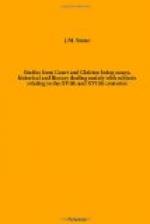* Dom. James I., vol. 109, May 1619; R.0.
The Bishop of Exeter reported that “John Lugge, organist, retains none of his popish tendencies, though his religion is as the market goes,” and he added that there were very few papists in his diocese, but an infinity of sectaries and atheists.
Many of these latter may have been secret Catholics, either extremely ignorant, or too timid to suffer for their faith. A book published in 1602, entitled The Unmasking of the Politique Atheist is a violent attack upon Catholicism. Another, called A Perfect Cure for Atheists, Papists, Arminians, etc., published in 1649, is of a like nature. It is a far cry from Aristotle to atheism, but no sooner did the votaries of the new learning discard a system of philosophy which, however exaggerated by pedants, was still a guarantee of exact reasoning, than their disciples and followers fell a prey to the vagaries of their own bewildered intellects.
It was the reductio ad absurdum of the reformed religion, when weak-kneed Catholics sheltered themselves from its pains and penalties under the fairly secure roof-tree of atheism.
VII. CHARLES THE FIRST AND THE POPISH PLOT
“A fine rare show arrives from Rome, and it is all a present for the Queen, and the news of it reaches London, and the King is impatient to see it; and the Queen is lying in, and Mr. Panzani brings all the fine things to the Queen’s bedchamber; and all the ladies of quality crowd in to see them; and the King with all his nobles hastens to the Queen’s palace; and the boxes are opened, and the pieces are viewed one by one; and Mr. Conn comes in (though still without a red hat) to satisfy the Queen’s curiosity, and Mr. Conn brings more fine pictures . . . and sees the King, and the Queen of France; and Mr. Panzani takes leave of the Queen of England (for how could he omit it?) and the Queen begs a red hat for Mr. Conn, and Mr. Conn must first do some signal service to the Church; and the King talks about Mr. Conn’s red hat; and the Queen gives Mr. Panzani a fine diamond ring; and Mr. Panzani takes leave of all the ministers; and he pays his respects to all the ladies of the court; and the ladies send their compliments to the Pope, and they all beg Mr. Panzani’s blessing. It was the end of the year 1636.”
This Sevigne-like description was written in 179-, by the Rev. Charles Plowden, in his “Remarks on a Book entitled Memoirs of Gregorio Panzani.” Panzani, a priest of the Roman Oratory, had been about two years in England, with a secret mission to report to Cardinal Barberini, nephew of Pope Urban VIII., on the condition of the Catholics, the condition of the court, and on the prospects regarding an ultimate reunion of the Anglican Church with Rome. He was to pave the way for an openly accredited envoy to the queen, was to conciliate the ministers, disarm the Puritans, and to do what he could for the Catholics,




